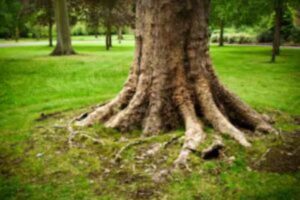Exposed tree roots may look cool in photos, but they are also trip hazards, can make mowing difficult, and can become an eyesore.
If roots begin growing on the surface of the soil, the tree can start to suffer. They might be scalded by the sun, trampled by foot traffic, and have trouble retaining moisture.
Why Do Tree Roots Become Exposed?

Erosion: Rain, stormwater runoff, and wind can erode the soil around the tree, leaving the roots exposed. This is especially common when trees are planted on hills or slopes.
Lack Of Space: Trees in confined spaces might not have enough space for their roots. When roots encounter obstacles, they end up growing closer to the surface and can even begin to crack pavements and sidewalks.
Maple trees fast-growing shade trees are susceptible to surface roots. If you are planting one of these trees, make sure that the soil won’t erode and there is enough space for their roots.
Over time, trees will naturally become more likely to have exposed roots.
How Do You Fix Exposed Tree Roots?
The best way to fix exposed tree roots is to create a mulch bed around the tree. This will not only cover the roots, but it will also provide a multitude of benefits for the tree.

Covering surface roots with mulch will:
- Reduce lawn mower damage
- Remove the risk of tripping on the root
- Help the soil retain more nutrients
- Prevent soil compaction
- Keep the roots moist
- Insulate the roots, helping to provide a buffer from temperature changes
How To Mulch Around Your Tree:
- Try to remove as much of the grass that is growing between the roots (where you plan to mulch). Doing this will ensure that the grass doesn’t grow right through the mulch you apply.
- Do not use a lawn mower, weed wacker, or round up, as these will damage the exposed roots.
- Apply the mulch in a ring, covering the exposed tree roots. The layer of mulch should be about 2-3 inches deep and should not touch the trunk of the tree. You don’t want to create a mulch volcano.
- Keep in mind that if you choose to use shredded wood, the layer should only be ~1 inch thick as it will absorb more water.
Don’t Make These 5 Common Mulching Mistakes
Don’t Try To Fix Exposed Roots By:
Covering Them With Top Soil: When you add layers of soil on top of exposed roots, you risk adding too much or packing the soil too tightly. This can stop roots from getting the water and oxygen they need. The roots also risk growing right through the topsoil. Plus, if your roots were exposed by erosion, the new topsoil you add will just be eroded again in a year or two.
Planting A Garden Over Them: Many homeowners are tempted to plant a garden on top of the exposed tree roots. This is a bad idea. When you plant flowers or shrubs underneath a tree, you force your tree to compete with new plants for water and nutrients. This typically ends in plant death.
Solve your exposed root issues the right way. By choosing to mulch, you will not only solve your current issue of exposed tree roots, but you will also improve the overall health of your tree.


